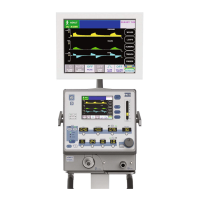TROUBLESHOOTING GUIDE
Table 3-1 may provide guidance in determining the cause and
possible corrective action for ventilator problems. Newport does
not guarantee that the suggested corrective action will solve the
problem.
Contact Newport Technical Service Department for additional
assistance.
Table 3-1 Troubleshooting Guide
SECTION 3
Problem Potential Cause Suggested Action
Fail Circuit Check Leak from patient circuit.
Leak from exhalation section.
Leak from inhalation section.
Leak from tubing connection inside
the ventilator.
Inspect patient circuit.
Disassemble exhalation valve to inspect
exhalation valve diaphragm and seal.
Inspect exhalation valve adapter.
Tighten inhalation flow outlet.
Tighten oxygen sensor.
Inspect emergency relief diaphragm.
Inspect pneumatic tubing inside the ven-
tilator.
Inspect TSI air/oxygen flow sensors
assembly.
Clean or replace emergency intake
diaphragm.
Inspect rubber seal between inhalation
outlet block and mixer block.
Flow Sensor Error/Bad Defective exhalation flow sensor.
Defective exhalation flow sensor
cables, outside and inside.
Defective cable from exhalation
sensor board to main board.
Defective exhalation sensor board.
Replace exhalation flow sensor.
Replace exhalation flow sensor cables,
outside and inside.
Replace cable from exhalation sensor
board to main board.
Replace the exhalation sensor board.
Ventilator cannot achieve
or maintain correct tidal
volume, plateau pressure,
or baseline pressure.
Pressure relief valve regulator
failure.
Crossover solenoid valve
(solenoid PCB) failure.
Machine zero solenoid (solenoid
PCB) valve failure.
Perform the Operational Verification
Procedure to diagnose the problem.
Replace any parts that may be
defective.
Pressure Bar graph does
not show pressure rise.
Machine zero solenoid (solenoid
PCB) valve failure.
Analog board malfunction.
Replace solenoid PCB and
Analog PCB.
SER360 A1106 3-1

